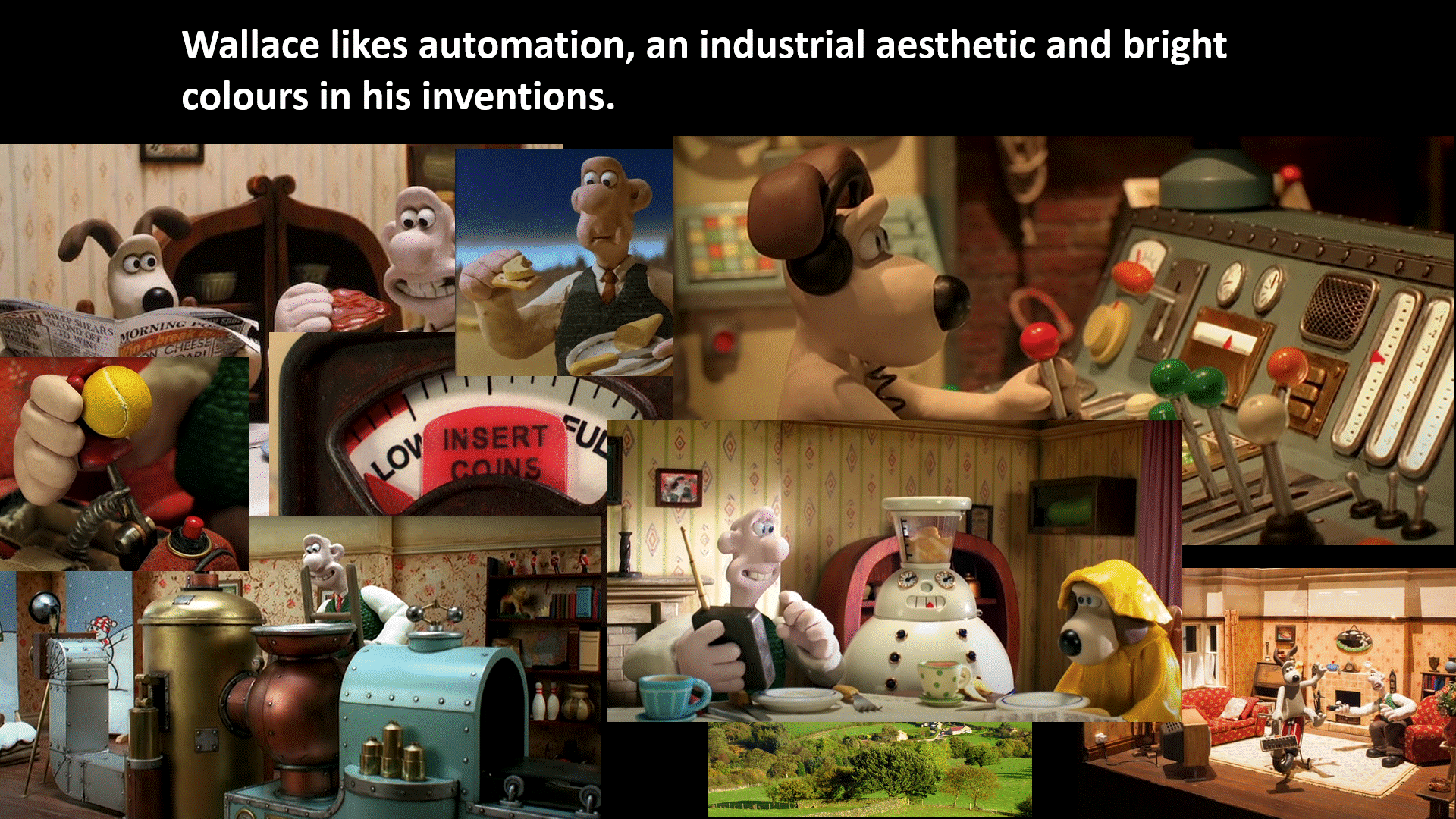
Imagine for a moment.
It’s the 1950s and you are a 30-year-old man living with your highly intelligent humanoid dog in the English countryside. Day in and day out you have to cook breakfast. It is so boring.
So you do what you do best as an inventor, and you build yourself a robot! Over a couple days time, you tinker, you toy, and you come up with a fully automatic breakfast robot—”The Autochef”.
The next morning, you're ready to have The Autochef cook you an amazing breakfast, but OOPS!
You forgot to make a remote.
You quickly hodgepodge together a few buttons and throw them into a box.
In the morning you go to place your order and you come up with
EGGS SCRAMBLED.
TEA FRIED?
You’re left pretty dissatisfied with your breakfast experience.

Your name is Wallace
Your dog’s name is Gromit
and this is…
The Breakfast
Gizmodoohickeythingamabob
Based on the Wallace and Gromit's Cracking Contraptions episode “The Autochef”
What is
The Breakfast
Gizmodoohickeythingamabob
The Breakfast Gizmodoohikeythingambob is an improved upon version of the remote Wallace hastily comes up with to control The Autochef.
It is not only better performing, but it also creates a more enjoyable breakfast ordering experience. Something Wallace will find adds value to his life every single day.
Levels of Design
Visceral
Does it look good?
Behavioral
Does it work good?
Reflective
Does it make you feel good?
?
The Challenge:
Keeping within the theme and context of
the world of Wallace and Gromit.
Aspects to preserve:
dark grey & brown hues
with an
industrial aesthetic
but still featuring
bright colors for emphasis
and it all
looks like clay
1.
2.
Wallace needs to make the all important decision
Egg, Tea, or does he dare do both?
3.
Wallace can choose his settings with the dial.
Here he’s chosen a fried egg and three cubes of sugar
4.
The UI
The user interface is designed, top-down, on the mental steps that Wallace goes though as thinks about his breakfast order.
Wallace wants to turn on The Autochef
So he presses the power button on the top
Once Wallace is happy with his decision
He can hit the big red button and
Start cooking!
Design Verification
The remote has been tested to ensure proper function, understandability, usability, and physical feel.
Each tester got told the scenario and truly embodied the mindset of Wallace, before we performed a cognitive walkthrough.
EGG & TEA:
An initial finding underlined the importance of tactile feedback as user’s had trouble understanding the the “EGG” and “TEA” buttons—primarily that both could be used at the same time.
The final prototype includes latching buttons. This provides both a physical and visual stimulus letting the user know that their order was successful and enabling them to discover that both options can be selected in a single order.
Final Prototype
Cook Buzzer:
Users were often unsure about whether their order successfully sent to the robot.
To make this more clear—and to end each morning with a bang—the big red “COOK” button activates a haptic motor, that makes an audible buzz and a physical vibration.
Lo-fi Prototype
Sugar Dial:
Originally, sugar levels were set with an incremental thumb wheel.
Although the intention was to give the user greater control over the sugar level. Users found this confusing and without verbal clarification, most thought they were selecting tea type or temperature.
The final prototype includes a another dial. Although longer incremental, the pictures of the dial mechanism make the setting very intuitive, requiring no clarification.
Electrical Prototype
Visual Design
Colour:
Similar to the designs seen in the show, the main body of the remote is an industrial brown, with each of the buttons standing out with their bright hue.
The remote has soft edges and a compact interface to best mimic the look and feel of an inventor’s gizmo, made of clay.
CLAY
Whilst attempting to recreate the remote out of clay I found that soft and smooth edges were the main visual element to recreate.
This easily integrated into our remote’s design, as the large fillets lend the design well toward the plastic injection molding manufacturing process.
Leading to a remote that is smooth, rounded, and manufacturable!
Style:
The industrial look is often characterized by its clutter and crowd.
The remote stays in keeping with that by having a compact interface—whilst following UI design heuristics to ensure that usability and understandability are maintained.
Reflection
Wallace is a mad inventor, who is incredibly stubborn and refuses to learn from his mistakes.
His flaws as an inventor lie not in mechanical or electrical engineering, but in human design—or in this case, the dog design.
Gromit is there, ready with a raincoat, because he knows his scrambled eggs aren't necessarily going on to his plate.
The remote’s ability to send accurate signals to the Autochef, gives Wallace a sense of pride through completion.
What this remote does for Wallace is not just create a more practical breakfast ordering experience for himself.
The Breakfast Gizmodoohickeythingamabob completes his marvelous invention, by allowing his robot to be actually used.
For once, his engineering genius actually truly solved a problem.
What he wants in the morning is what he gets, that is what this remote does for Wallace.
Similarly, this remote is appealing to me too. Not because I have an Autochef waiting for me at home, but because I have seen the stories of Wallace and Gromit all my life.
To me that it's amazing that you can take something from this magically mechanized world, hold it in your hand, and still appreciate it for what it is.
The full report can be accessed here











